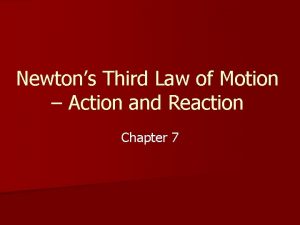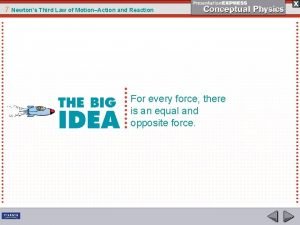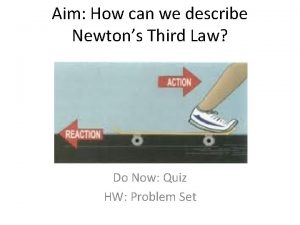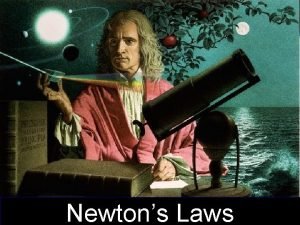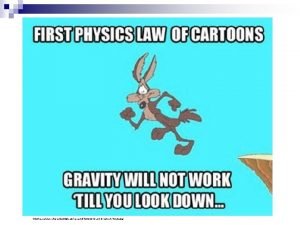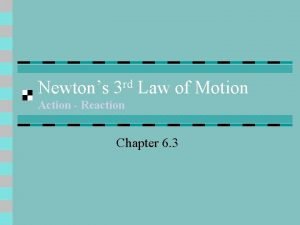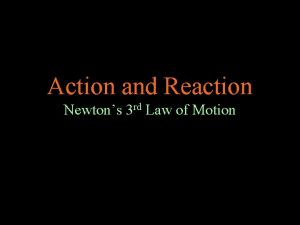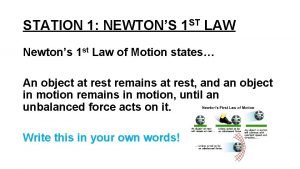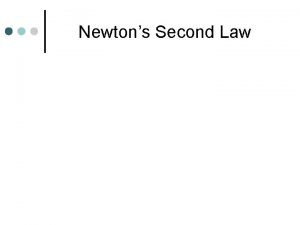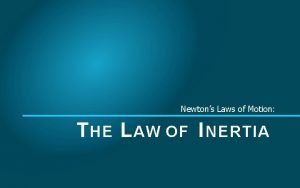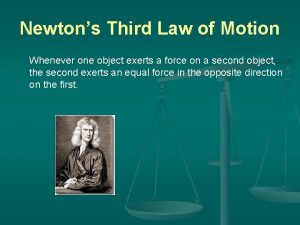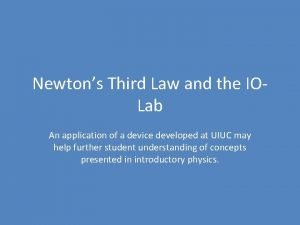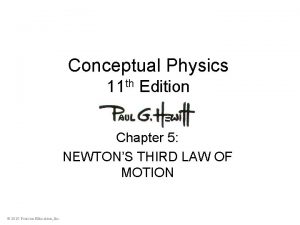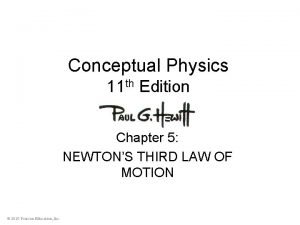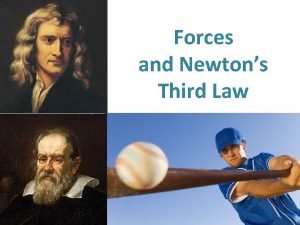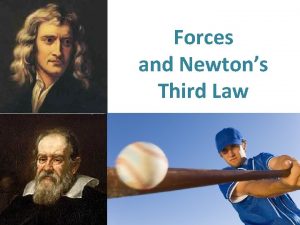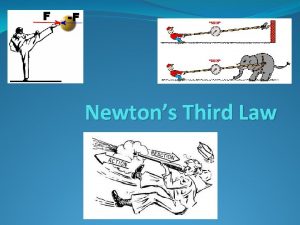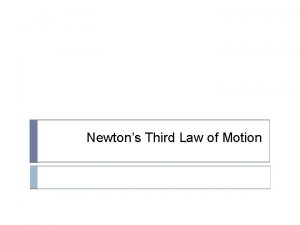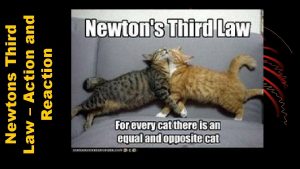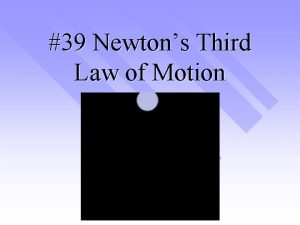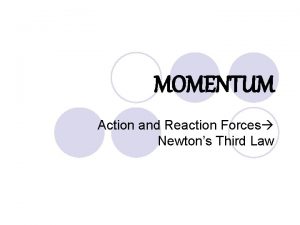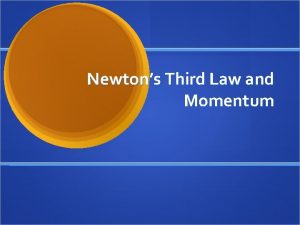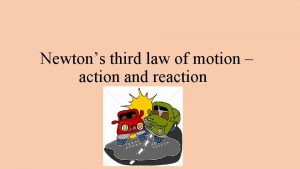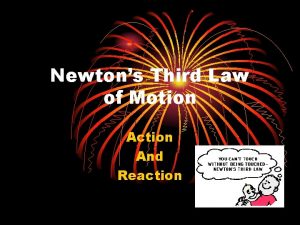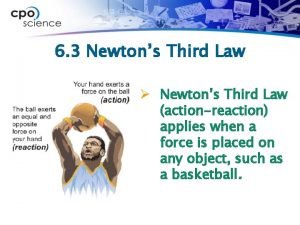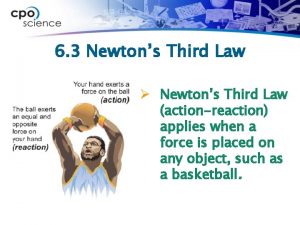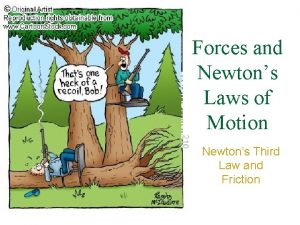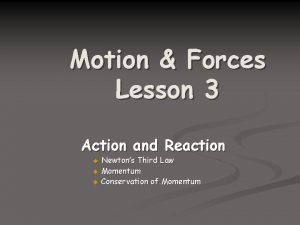Motion Forces Action and Reaction Newtons Third Law





























- Slides: 29

Motion & Forces Action and Reaction Newton’s Third Law u Momentum u Conservation of u

A. Newton’s Third Law l Newton’s Third Law of Motion When one object exerts a force on a second object, the second object exerts an equal but opposite force on the first.

A. Newton’s Third Law l “For every action there is an equal and opposite reaction. ”

A. Newton’s Third Law l Action-Reaction Pair

A. Newton’s Third Law l Action-Reaction Pair

A. Newton’s Third Law l Action-Reaction The rocket exerts a downward force on the exhaust gases. l The gases exert an equal but opposite upward force on the rocket. l FG FR Pairs

A. Newton’s Third Law l Physics of walking

A. Newton’s Third Law l Propulsion of fish through water § A fish uses its fins to push water backwards. In turn, the water reacts by pushing the fish forwards.

A. Newton’s Third Law l Action-Reaction Pairs l The hammer exerts a force on the nail to the right. l The nail exerts an equal but opposite force on the hammer to the left.

A. Newton’s Third Law l Consider the interaction between a baseball bat and baseball. § Action: the baseball forces the bat to the right. § Reaction: ?

A. Newton’s Third Law l Using a diving board to spring into the air before a dive is a good example of Newton’s third law of motion. Explain.

Newton’s Third Law Newton vs. Elephant Who will move fastest?

A. Newton’s Third Law l Action-Reaction l Both Pairs objects accelerate. l The amount of acceleration depends on the mass of the object. F m l Small mass more acceleration l Large mass less acceleration

A. Newton’s Third Law l http: //esamultimedia. esa. int/docs/ issedukit/en/activities/flash/start_t oolbar. html#ex 03_gm 01. swf

A. Newton’s Third Law l While driving, you observe a bug striking the windshield of your car. Obviously, a case of Newton’s third law! The bug hits the windshield and the windshield hits the bug. Is the force on the bug or the force on the windshield greater?

B. Momentum l Momentum § “mass in motion” § Depends on object’s mass and velocity. § The more momentum an object has, the harder it is to stop. § It would require a greater amount of force or a longer amount of time or both to bring an object with more momentum to a stop.

B. Momentum l Momentum p = mv p m v p: m: v: momentum (kg ·m/s) mass (kg) velocity (m/s)

B. Momentum and Impulse l Newton’s 2 nd Law Impulse = Change of momentum

B. Momentum and Impulse

B. Momentum l Find the momentum of a bumper car if it has a total mass of 280 kg and a velocity of 3. 2 m/s. GIVEN: WORK: m = 280 kg p = mv v = 3. 2 m/s p = (280 kg)(3. 2 m/s) p=? p = 896 kg·m/s p m v

C. Conservation of Momentum l Law of Conservation of Momentum § The total momentum in a group of objects doesn’t change unless outside forces act on the objects. pbefore = pafter

C. Conservation of Momentum l If momentum is lost by one object, it must be gained by another object in the system so that the total momentum of the system is constant.

C. Conservation of Momentum l Collision between 1 -kg cart and 2 -kg dropped brick l Momentum of the loaded cartdropped brick system is conserved

C. Conservation of Momentum l Big fish in motion catches little

C. Conservation of Motion l Little fish in motion is caught by big fish

C. Conservation of Momentum l Elastic Collision (KE conserved) l Inelastic Collision (KE not conserved)

C. Conservation of Momentum l. A 5 -kg cart traveling at 4. 2 m/s strikes a stationary 2 -kg cart and they connect. Find their speed after the collision. BEFORE Cart 1: p = 21 kg·m/s m = 5 kg v = 4. 2 m/s Cart 2 : m = 2 kg v = 0 m/s p=0 pbefore = 21 kg·m/s AFTER Cart 1 + 2: m = 7 kg v=? p m v v=p÷m v = (21 kg·m/s) ÷ (7 kg) v = 3 m/s pafter = 21 kg·m/s

C. Conservation of Momentum l. A 50 -kg clown is shot out of a 250 -kg cannon at a speed of 20 m/s. What is the recoil speed of the cannon? BEFORE AFTER Clown: m = 50 kg v = 0 m/s p=0 Clown: p = 1000 kg·m/s m = 50 kg v = 20 m/s Cannon: m = 250 kg v = 0 m/s p=0 Cannon: p = -1000 kg·m/s m = 250 kg v = ? m/s pbefore = 0 pafter = 0

C. Conservation of Momentum l So…now GIVEN: we can solve for velocity. WORK: p = -1000 kg·m/s v = p ÷ m m = 250 kg v = (-1000 kg·m/s)÷(250 kg) v=? v = - 4 m/s p (4 m/s backwards) m v
 According to the third law of motion action and reaction
According to the third law of motion action and reaction Law of motion 3rd
Law of motion 3rd Third law of motion
Third law of motion Newton's third law
Newton's third law Newton's third law
Newton's third law Newton's first law and second law and third law
Newton's first law and second law and third law Si unit of newton's first law
Si unit of newton's first law Describe newtons third law
Describe newtons third law Law of thermodynamics in chemistry
Law of thermodynamics in chemistry Newton's laws of motion
Newton's laws of motion Newton's third law of motion is also known as the law of
Newton's third law of motion is also known as the law of Newtons 3 rd law of motion
Newtons 3 rd law of motion Newtons 3 rd law of motion
Newtons 3 rd law of motion Newtons 3 rd law of motion
Newtons 3 rd law of motion Newton's first law of motion meme
Newton's first law of motion meme Newtons 3 rd law of motion
Newtons 3 rd law of motion Newton's 3 law
Newton's 3 law Newtons 3 rd law of motion
Newtons 3 rd law of motion Newton's first law
Newton's first law Newton's 2nd law
Newton's 2nd law Examples for newton's second law of motion
Examples for newton's second law of motion Brainpop newton's laws of motion worksheet answer key
Brainpop newton's laws of motion worksheet answer key What is reaction force
What is reaction force Newtons third lw
Newtons third lw Newtons third aw
Newtons third aw Newton's first law
Newton's first law Gadgets based on newton's third law of motion
Gadgets based on newton's third law of motion What are the 3 newton's laws
What are the 3 newton's laws Slightly tilted wings of airplanes deflect
Slightly tilted wings of airplanes deflect Slightly tilted wings of airplanes deflect
Slightly tilted wings of airplanes deflect
